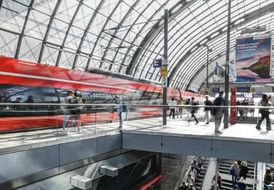Key economic performance indicators
- The development of operating profit led to an improvement in ROCE and debt coverage.
Value management targets / % | ROCE | Redemption coverage |
DB Group | ≥6.0 | ≥20 |
Integrated Rail System | ≥5.4 | ≥15 |
Transport operators (Integrated Rail System), DB Arriva, DB Schenker | ≥11.0 | ‒ |
Infrastructure | ‒ | ≥15 |
DB Netze Track | 3.41 | ‒ |
DB Netze Stations | 3.55 | ‒ |
DB Netze Energy 1) | 5.50 | ‒ |
1) Calculated using a capital asset pricing model (CAPM), as the Federal Network Agency has not set any weighted cost of capital (WACC), but system-specific costs of equity.
In 2022, the ROCE targets for DB Group and the Integrated Rail System were adjusted:
- The increase in interest rates, together with increased capital market yields, led to higher cost of capital and therefore an increase in the target returns for the transport operators in the Integrated Rail System, DB Arriva and DB Schenker.
- Since 2022, the cost of capital (before taxes) approved by the Federal Network Agency have been the target ROCE for the regulated infrastructure business units.
At DB Group, profitability is a material requirement for financing capital expenditures in our core business, further developing our businesses and seizing opportunities for future growth.
In the context of our value management, we intend to manage DB Groupʼs enterprise value over the long term such that we can finance capital expenditures in our core business. DB Group’s financial leadership and management – and therefore also monitoring the success of our economic targets – is carried out via a value management system based on key performance indicators. The results are an important factor for our strategic approach, our capital expenditure decisions and employee and management remuneration.
- Profitability as an overarching target in value management aims to ensure a long-term reasonable rate of return over several economic cycles. On the basis of market values, we calculate the annual cost of capital as a weighted average from risk-adequate market returns on equity and debt capital. The actual yield, the return on capital employed (ROCE) is calculated as the ratio of operating profit before interest and taxes (EBIT adjusted) to capital employed. The ROCE target is set higher than the cost of capital. The long-term objective is to achieve an ROCE whose multi-year average reaches the target value, ensuring that the cost of capital is covered. This ROCE target corresponds to the minimum required rate of return (MRR). The different business characteristics result in different target values for our activities in passenger transport, in logistics and in rail freight transport as well as in infrastructure. Since 2022, the cost of capital and therefore also the expected return in the infrastructure business units have been based on the capital costs approved by the Federal Network Agency. The derived target value of the Integrated Rail System is based on the value-weighted return expectations for the allocated business units. The operating business is always controlled before taxes and, accordingly, the reporting of key figures is based mainly on pre-tax figures.
- Financial stability is an essential component for sustainable economic activity. For DB Group with its asset-intensive business, it is essential that it has access to the capital market under good conditions at all times. A major objective is therefore to achieve adequate key debt ratios. Our key figure for managing indebtedness is debt coverage. The target value is derived from credit rating key figures and annual benchmarking with comparable companies with an excellent credit rating.


